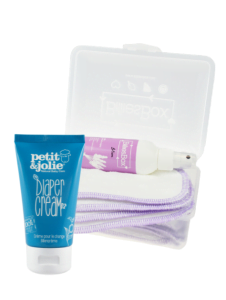Nappy Rash
How to Get Rid of It?
Nappy rash is a common skin condition in babies. Few children escape it. The severity can vary greatly, from a little redness to blisters and even open sores. Either way, it can be quite uncomfortable.
But what exactly is diaper rash?
Diaper rash is irritated skin in the baby’s diaper area. The rash can have different degrees, namely:
- Redness and sensitivity of the skin.
- Swelling of the skin.
- Blisters on the skin.
- Opened skin that may even bleed.
In all cases, touching the skin will be sensitive for your child.
How does diaper rash develop?
It is important to know that the skin in the diaper area is thinner, so it can irritate more quickly than, for example, your arms or legs. Diaper rash can have several causes:
- Prolonged exposure to moisture: The skin becomes more irritated in a moist environment from urine and feces.
- Friction: Diapers that do not fit properly cause friction and can irritate the skin.
- Teething: This often requires a lot of energy from babies, which can reduce resistance and make the skin more sensitive.
- Diet: Certain foods, such as acidic fruits and strong herbs, can irritate the skin through the feces. This can also happen through breastfeeding.
- Sensitive skin: Some babies naturally have more sensitive skin that is more prone to diaper rash.
- Bacterial or fungal infections: The warm, moist environment in diapers promotes the growth of bacteria or fungi. A fungal infection often occurs after prolonged irritation of the skin.
How do you distinguish diaper rash from a yeast infection?
The difference is sometimes difficult to see. In general, if your baby has just developed diaper rash, this is not yet a yeast infection. A fungal infection, also called diaper dermatitis candidiasis, usually occurs after prolonged irritation. The infection is caused by a yeast, usually Candida albicans.
Signs of a yeast infection in diaper rash include:
- More intense redness: The rash may be brighter red than regular diaper rash.
- Red spots with sharp edges: The area may have red spots with clear boundaries.
- Small red bumps: Sometimes small bumps appear around the edges of the rash.
- Small white spots: small white spots that resemble small pimples, often indicating a yeast infection.
What is the best way to treat diaper rash?
Prevention is always best way, but almost every child will experience it at some point. It is best to take the following steps:
- Airing, lots of airing: We are in favor of this, let the skin dry thoroughly in the air by letting your baby be without a diaper for a while.
- Regular changing: Change the diaper regularly, preferably immediately after urinating or defecating. This way, the skin stays in a moist environment for as short a time as possible.
- Mild cleaning without chemicals: Use soft wipes without chemicals and do not rub too hard. The washable baby wipes from BilliesBox are ideal for this.
- Protective cream or ointment: a diaper cream with the right ingredients such as zinc oxide and a fatty ingredient ensures a drying effect of the zinc oxide and a moisture barrier between the urine and the skin. Please note: if the skin has wounds, creams can be painful. The diaper cream from Petit&Jolie contains zinc oxide and beeswax and wool fat as greasy ingredients. The diaper cream also contains sesame oil, which has an anti-inflammatory effect.
- Correct diaper fit: Make sure the diaper fits properly to prevent friction.
- Cloth diapers: These are softer and do not contain chemicals, making them gentler on the skin.
If you have a fungal infection in the diaper area, it is wise to use an antifungal cream, which is available at the drugstore. If the rash persists, contacting your doctor is advisable.






